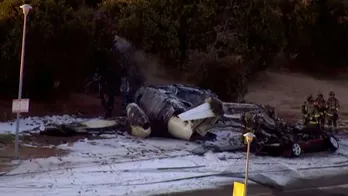Alaska Airlines flight makes emergency landing in Oregon after window blows out
PORTLAND, Ore. — An Alaska Airlines flight made an emergency landing in Oregon on Friday after a window and a chunk of its fuselage blew out in mid-air shortly after takeoff.
A passenger sent KATU-TV a photo showing a gaping hole in the side of the airplane next to passenger seats. It was not immediately clear if anyone was injured.
The airline said the plane landed safely with 174 passengers and six crew members.
"Alaska Airlines Flight 1282 from Portland, Oregon, to Ontario, California, experienced an incident this evening soon after departure," the company said in an emailed statement.
The airline said it would share more information when it became available.
The plane was diverted after rising to 16,000 feet (4,876 meters) about about six minutes after taking off at 5:07 p.m., according to flight tracking data from the FlightAware website. It landed again at 5:26 p.m.
KPTV-TV reported photos sent in by a passenger showed a large section of the airplane's fuselage was missing.
The Federal Aviation Administration said the plane landed safely after the crew reported a pressurization issue. The agency said it would investigate.
The National Transportation Safety Board said in a post on X, formerly known as Twitter, that it was investigating an event on the flight and would post updates when they are available.
The Boeing 737-9 MAX rolled off the assembly line and received its certification just two months ago, according to online FAA records.
Boeing said it was aware of the incident, working to gather more information and ready to support the investigation.
The Max is the newest version of Boeing's venerable 737, a twin-engine, single-aisle plane frequently used on U.S. domestic flights. The plane went into service in May 2017.
Two Max 8 jets crashed in 2018 and 2019, killing 346 people, leading to a near two-year worldwide grounding of all Max 8 and Max 9 planes. The planes returned to service only after Boeing made changes to an automated flight control system implicated in the crashes.
Max deliveries have been interrupted at times to fix manufacturing flaws. The company told airlines in December to inspect the planes for a possible loose bolt in the rudder-control system.
Disclaimer: The copyright of this article belongs to the original author. Reposting this article is solely for the purpose of information dissemination and does not constitute any investment advice. If there is any infringement, please contact us immediately. We will make corrections or deletions as necessary. Thank you.







